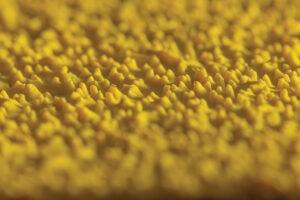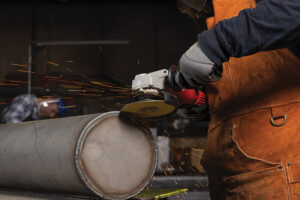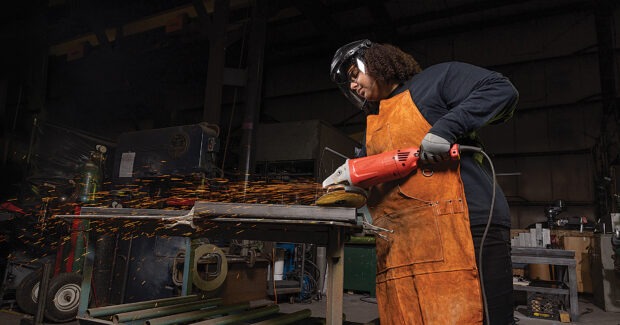Right Angle Grinding Abrasives Make Giant Performance Leap in Challenging Applications
New engineered shaped ceramic grain stays sharp and keeps cutting with no significant increase in pressure throughout the life of the disc.
Posted: January 24, 2024

Today’s requirements for right angle grinding solutions are changing, and abrasives technology must keep up by offering high productivity, speed and long life on even the toughest materials. To appreciate where the off-hand grinding abrasive industry is today, it is helpful to review where it started and how it advanced.
Abrasives Technology Evolves
Historically, operators performed right angle grinding primarily on carbon steel using grinding wheels or aluminum oxide grain on a fiber backing, a.k.a. fiber disc, to remove welds or bevel parts. Grinding wheels were used for medium to large welds because of the improved performance and life when compared with using the fiber discs that were available at that time.
Zirconium grain was the next advancement, which reduced grinding time and the number of fiber discs required to complete the job. After that, ceramic grain was invented and incorporated into fiber discs, further reducing grind times and lasting longer than previous fiber abrasive products. The continued advancement of newer ceramics and topcoats/supersize coatings pushed the boundaries even further, improving fiber disc performance.
An Engineering Breakthrough

Carbon steel is still used in a large portion of today’s grinding applications, but challenging components made of aluminum, Inconel, stainless, and titanium have significantly increased. To address the increasingly demanding grinding challenges that fabricators and manufacturers are facing, a new engineered shaped ceramic grain has come on the scene: the all-new Norton RazorStar™ fiber discs, quick-change discs and belts feature a 100% engineered-shaped ceramic grain with a supersize coating, offering a single abrasives solution for removing welds, grinding, beveling and heavy deburring on carbon steels and other hard-to-grind metals.
These new fiber discs are designed for medium to high-pressure metal removal in the most demanding grinding applications. A unique engineered shaped ceramic grain cuts faster and removes more material, while allowing operators to apply less pressure for an ergonomic and user-friendly solution which reduces fatigue. In addition, the reduced pressure may extend the life of the right angle grinder.
Applying lower pressure also maximizes performance by reducing heat that causes metal capping. The unique geometry and tough micro-structure enable the grain to stay sharp, as new cutting points are exposed when the grain fractures. The advanced process also allows a higher percentage of grain to be oriented in an upright position compared to competitive shaped grain products, resulting in more grain tips cutting the metal.
Unique Grain
The new engineered shaped ceramic grain was designed by using breakthrough technology, so as the grain wears away, it stays sharp and keeps cutting with no significant increase in pressure throughout the life of the disc. Conventional grains and other shaped grain products require the operator to increase pressure as the grain wears. This increases the force the operator must apply and requires additional amps on the grinder.
Proven Performance
Internal testing versus a standard ceramic disc shows that the newly engineered shaped ceramic grain can remove up to 100% more material with less disc wear and require less power per gram to remove. Using less power means the operator and machine are more efficient.
In one test with carbon steel, the new engineered shaped ceramic grain discs removed 2,000 more grams than the standard ceramic grain discs. The performance exceeds conventional fiber discs by removing more material at a faster cut rate.
The new discs also offer operators several compelling advantages to grinding wheels. For large welds, the discs have a faster cut rate and more material removed per second, with less vibration and noise compared with grinding wheels. Fiber discs are also easier to use when training new operators, providing a safer, more efficient alternative to grinding wheels.
Usage Tips
These abrasives feature an engineered shaped ceramic grain and can be run on the same off-hand grinders currently used with standard ceramic abrasive products. Of course, the grinder still needs to be strong enough for the application. If the application is light pressure, a less expensive lower amp grinder can be used. If the application is more demanding, a higher amp grinder is required. Usually, the latter has a higher upfront cost, but over the grinder’s life, you will save costs by buying fewer grinders, and operation time will be lower because greater pressure and more rigid backup pads can be used.
The correct backup pad must be rated for the grinder being used. Guards on the grinder should always be used to prevent operator injury. Also, the ideal storage room temperature should range from 60°-to- 80° Fahrenheit with humidity levels between 35% and 50%.


















